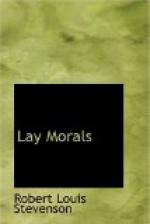In every page the book is stamped with the same energy of vision and the same energy of belief. The quality is equally and indifferently displayed in the spirit of the fighting, the tenderness of the pathos, the startling vigour and strangeness of the incidents, the natural strain of the conversations, and the humanity and charm of the characters. Trivial talk over a meal, the dying words of heroes, the delights of Beulah or the Celestial City, Apollyon and my Lord Hate-good, Great-heart, and Mr. Worldly-Wiseman, all have been imagined with the same clearness, all written of with equal gusto and precision, all created in the same mixed element, of simplicity that is almost comical, and art that, for its purpose, is faultless.
It was in much the same spirit that our artist sat down to his drawings. He is by nature a Bunyan of the pencil. He, too, will draw anything, from a butcher at work on a dead sheep, up to the courts of Heaven. ‘A Lamb for Supper’ is the name of one of his designs, ‘Their Glorious Entry’ of another. He has the same disregard for the ridiculous, and enjoys somewhat of the same privilege of style, so that we are pleased even when we laugh the most. He is literal to the verge of folly. If dust is to be raised from the unswept parlour, you may be sure it will ’fly abundantly’ in the picture. If Faithful is to lie ‘as dead’ before Moses, dead he shall lie with a warrant—dead and stiff like granite; nay (and here the artist must enhance upon the symbolism of the author), it is with the identical stone tables of the law that Moses fells the sinner. Good and bad people, whom we at once distinguish in the text by their names, Hopeful, Honest, and Valiant-for-Truth, on the one hand, as against By-ends, Sir Having Greedy, and the Lord Old-man on the other, are in these drawings as simply distinguished by their costume. Good people, when not armed cap-a-pie, wear a speckled tunic girt about the waist, and low hats, apparently of straw. Bad people swagger in tail-coats and chimney-pots, a few with knee-breeches, but the large majority in trousers, and for all the world like guests at a garden-party. Worldly-Wiseman alone, by some inexplicable quirk, stands before Christian in laced hat, embroidered waistcoat, and trunk-hose. But above all examples of this artist’s intrepidity, commend me to the print entitled ‘Christian Finds it Deep.’ ’A great darkness and horror,’ says the text, have fallen on the pilgrim; it is the comfortless deathbed with which Bunyan so strikingly concludes the sorrows and conflicts of his hero. How to represent this worthily the artist knew not; and yet he was determined to represent it somehow. This was how he did: Hopeful is still shown to his neck above the water of death; but Christian has bodily disappeared, and a blot of solid blackness indicates his place.




